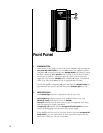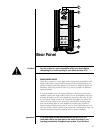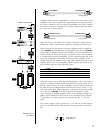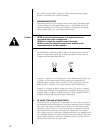
18
use, the amplifiers will operate out of phase with each other,
resulting in a loss of bass and poor imaging.
Although the best form of balanced interconnection is via a balanced cable
and XLR connectors, it is possible to operate the Nº33 in a balanced con-
figuration by using both inverting and non-inverting RCA inputs
simulataneously. This approach is generally less desirable, however, since
separate single-ended cables will be more susceptible to noise pickup than
a single balanced cable. If this approach is taken, you must remove the
shorting strap from the XLR input. Save it for possible use at a later date.
2 BALANCED AUDIO INPUT
Accepts a signal from a preamplifier with balanced outputs via a high qual-
ity XLR connector. If connection to the preamplifier is made with a bal-
anced interconnecting cable, it is important to remove the shorting plug
from between pins #1 and #3 of the XLR input which was placed there
prior to shipment from the factory. Save it for possible use at a later date.
The pin assignments of this XLR-type female input connector is:
PUSH
21
3
Pin 1: Signal ground
Pin 2: Signal + (non-inverting)
Pin 3: Signal – (inverting)
Connector ground lug: chassis ground
These pin assignments are consistent with the standards adopted by the
Audio Engineering Society. Refer to the operating manual of your balanced-
output preamplifier to verify that the pin assignments of its output connec-
tors correspond to your Mark Levinson Nº33. If not, wire the cables so that
the appropriate output pin connects to the equivalent input pin.
3 COMMUNICATIONS LINK AND REMOTE TURN-ON INPUTS
The Nº33 may be controlled by a “linked” Mark Levinson 30-series pream-
plifier when the slave in communications port is connected to the master
port of the preamplifier. Subsequent Nº33 amplifiers may be “daisy chained”
from the first Nº33’s slave out to their slave in port, up to a maximum of
six amplifiers total.
slave out
remote turn-on jacks
communications ports
slave in
A “straight-through,” six conductor Link cable with six-conductor modular
connectors on both ends is used to connect the preamplifier to the first
power amplifier. Such a cable is made (counter-intuitively) by incorporating
a 180° twist into the cable before terminating it, as shown below:


















